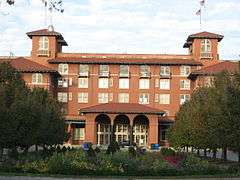South Shore Cultural Center
|
South Shore Country Club | |
|
South Shore Country Club | |
   | |
| Location | 7059 S. South Shore Dr., Chicago, Illinois |
|---|---|
| Coordinates | 41°46′11″N 87°33′46″W / 41.76972°N 87.56278°WCoordinates: 41°46′11″N 87°33′46″W / 41.76972°N 87.56278°W |
| Area | Chicago |
| Built | 1908 |
| Architect | Marshall & Fox[1] |
| Architectural style | Mediterranean Revival[1] |
| NRHP Reference # | 75000652[2] |
| Significant dates | |
| Added to NRHP | March 4, 1975 |
| Designated CL | May 26, 2004 |
The South Shore Cultural Center, in Chicago, Illinois, is a cultural facility located at 71st Street and South Shore Drive, in the city's South Shore neighborhood. It encompasses the grounds of the former South Shore Country Club.
The South Shore Country Club was founded in 1905 as a suburban counterpart to the urban clubs of Chicago, such as the Athletic Club. The original building was built at that time, designed by architects Marshall and Fox in a Mediterranean Revival style. In 1909, a theater was added, but in 1916, Marshall and Fox were engaged to design a newer building, still in the Mediterranean Revival style. This is the building that still stands. Originally built as a Protestant-only club, later, Irish-Catholics were admitted.
Besides the main clubhouse, the Country Club also had stables, a nine-hole golf course, tennis courts, a bowling green, and a private beach on Lake Michigan.
By the early 1960s, the character of the neighborhood was changing rapidly. As Hyde Park, Woodlawn, and South Shore became racially integrated, the wealthy whites who formed the membership in the club started to leave the neighborhood in droves. In 1967, the club considered opening its membership to Jews (for the first time since the 1930s) and African Americans (for the first time ever). The decision at that time not to open membership accelerated the decline of the club; in 1973, the decision was made to liquidate its assets, and in 1975, the property was sold to the Chicago Park District for $9,775,000.
It was listed on the U.S. National Register of Historic Places in 1975.[2]
A coalition of neighborhood activists and historic preservationists successfully convinced the Park District not to demolish the buildings. Instead, the facility was renamed the South Shore Cultural Center. Over two decades, the main buildings were slowly renovated and repurposed. Other buildings were torn down.
Today the Cultural Center houses the South Shore Cultural Center School of the Arts (youth and teen programs, community art classes, the Paul Robeson Theatre, a Fine Art Gallery, two dance studios, music practice rooms, and a visual arts studio with a kiln). In addition, there are banquet facilities for rent for weddings, receptions, and meetings. The golf course is still in operation, and is open to the public, as are the beach, picnic areas, gardens, and a nature center. The horse stables are currently used by the Chicago Police Department's mounted unit. The building houses the Parrot Cage Restaurant, which is operated as a teaching program of the Washburne Culinary Institute.[3] The Chicago Lakefront Trail (abbreviated as LFT) is an 18-mile multi-use path in Chicago, Illinois along the coast of Lake Michigan and runs past the center.
The center now competes with the Jackson Park 63rd Street Beach House and Promontory Point as South Side beachfront special use facilities in the Park District.
The building's exteriors were used as the "Palace Hotel Ballroom" in The Blues Brothers. The Cultural Center was the site of Barack and Michelle Obama's wedding reception on October 3, 1992. On May 26, 2004, it became a Chicago Landmark.[1]
Gallery
 Entrance Gate to the South Shore Cultural Center
Entrance Gate to the South Shore Cultural Center- Driveway leading to South Shore Cultural Center
 Interior ballroom at the South Shore Cultural Center
Interior ballroom at the South Shore Cultural Center
References
- 1 2 3 "Chicago Landmarks". Chicago Landmarks. City of Chicago. 2009-11-23.
- 1 2 National Park Service (2008-04-15). "National Register Information System". National Register of Historic Places. National Park Service.
- ↑ "Parrot Cage Restaurant". Retrieved 2010-01-02.
